-
 Bitcoin
Bitcoin $106,437.2012
0.82% -
 Ethereum
Ethereum $2,442.5287
0.82% -
 Tether USDt
Tether USDt $1.0005
-0.02% -
 XRP
XRP $2.1812
-0.27% -
 BNB
BNB $645.1327
0.45% -
 Solana
Solana $146.2379
0.39% -
 USDC
USDC $0.9999
-0.01% -
 TRON
TRON $0.2751
0.92% -
 Dogecoin
Dogecoin $0.1662
-0.23% -
 Cardano
Cardano $0.5827
-1.22% -
 Hyperliquid
Hyperliquid $37.5225
0.04% -
 Bitcoin Cash
Bitcoin Cash $479.0877
4.02% -
 Sui
Sui $2.7846
-3.27% -
 Chainlink
Chainlink $13.3576
0.84% -
 UNUS SED LEO
UNUS SED LEO $9.0252
-1.20% -
 Stellar
Stellar $0.2455
-1.07% -
 Avalanche
Avalanche $18.0680
-1.81% -
 Toncoin
Toncoin $2.8948
-1.07% -
 Shiba Inu
Shiba Inu $0.0...01164
-1.65% -
 Litecoin
Litecoin $85.0637
-0.06% -
 Hedera
Hedera $0.1526
-0.89% -
 Monero
Monero $316.2941
0.78% -
 Ethena USDe
Ethena USDe $1.0003
-0.04% -
 Polkadot
Polkadot $3.4113
-1.87% -
 Dai
Dai $1.0000
-0.01% -
 Bitget Token
Bitget Token $4.4488
5.16% -
 Uniswap
Uniswap $7.1740
3.09% -
 Pi
Pi $0.5968
11.43% -
 Pepe
Pepe $0.0...01010
-0.65% -
 Aave
Aave $264.3189
0.40%
What is the signal of an immediate rebound after the gap is filled? Should I intervene?
Cryptocurrency gaps occur when prices jump without trading in between, often due to high volatility or major news events.
Jun 25, 2025 at 01:15 pm
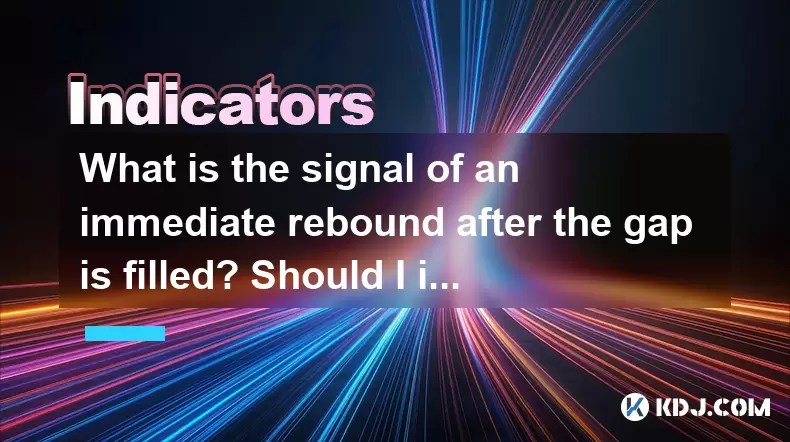
Understanding Gaps in Cryptocurrency Trading
In cryptocurrency trading, a gap occurs when the price of an asset jumps from one level to another without any trading happening in between. This typically happens during periods of high volatility or after significant news events that impact market sentiment overnight or over weekends. The phenomenon is common in crypto due to its 24/7 nature and frequent external influences such as regulatory changes, macroeconomic shifts, or technological developments.
Gaps can be classified into different types: common gaps, breakaway gaps, runaway gaps, and exhaustion gaps. Each type provides varying levels of insight into potential future price action. For traders, understanding which category a gap falls into helps determine whether it's likely to be filled quickly or if it signals a continuation or reversal of a trend.
What Does It Mean When a Gap Is Filled?
When a gap is filled, it means the price has returned to the level it had before the gap occurred. For example, if Bitcoin drops sharply from $30,000 to $28,500 overnight due to negative news, and later climbs back up to $30,000, the gap is considered filled.
The filling of a gap often indicates market equilibrium restoration — meaning buyers and sellers have adjusted their expectations and re-established balance. In some cases, once the gap is filled, the price may continue moving in the original direction. However, in other situations, especially with exhaustion gaps, a fill could precede a sharp reversal.
Identifying Signals of an Immediate Rebound After Gap Fill
Recognizing the signs of a potential rebound immediately after a gap is filled requires careful analysis of volume, candlestick patterns, and support/resistance levels.
- Volume spikes at the point of gap fill suggest strong institutional or retail participation, which can indicate the start of a new move.
- Bullish candlestick patterns, such as hammer, engulfing, or morning star formations, near the gap-fill zone are positive indicators of a possible bounce.
- Support zones aligning with the gap-fill area can act as psychological or technical floors where buying pressure outweighs selling pressure.
- Moving averages like the 20-period or 50-period EMA converging near the gap fill can serve as dynamic support, reinforcing the likelihood of a rebound.
It’s important to note that not all gap fills result in immediate rebounds. Context matters significantly. A gap fill occurring during a downtrend might just be a temporary pause before further declines, whereas in a bullish trend, it could mark a healthy retracement before resumption.
Should You Intervene Immediately After the Gap Is Filled?
Deciding whether to intervene right after a gap is filled depends on multiple factors including your trading strategy, risk tolerance, and time horizon.
If you're a swing trader, waiting for confirmation through candlestick closure above or below the gap-fill zone may provide better clarity. Entering too early could expose you to false breakouts or whipsaws, especially in highly volatile assets like cryptocurrencies.
For day traders, using tight stop losses and quick profit targets around the gap-fill area can be effective. Monitoring order flow and watching for rejection candles or momentum divergence can help in timing entries more precisely.
- Use limit orders near key support/resistance areas instead of market orders to avoid slippage.
- Check for confluence with Fibonacci retracement levels or pivot points to increase probability of success.
- Monitor order books and liquidity walls on platforms like Bitstamp or Binance to gauge institutional interest near the gap zone.
Risk management remains critical. Even if all technical conditions align, unexpected news or whale movements can distort normal behavior.
Tools and Indicators That Can Help Confirm a Rebound
To enhance your decision-making process, certain technical tools can be used alongside price action analysis.
- Relative Strength Index (RSI) showing oversold conditions (<30) near the gap-fill zone can hint at exhaustion among sellers.
- MACD crossing above the signal line after a prolonged downtrend can confirm momentum shift.
- Ichimoku Cloud interaction can show whether the gap fill occurred within a strong support/resistance zone or outside of it.
- Order block levels identified through institutional footprints can offer precise entry zones with favorable risk-reward ratios.
These tools should not be used in isolation but rather as part of a broader analytical framework that includes both technical and fundamental context.
Frequently Asked Questions
Q: Are gap fills more reliable in certain cryptocurrencies?
Yes, gap fills tend to be more reliable in major cryptocurrencies like Bitcoin and Ethereum due to higher liquidity and institutional presence. Lesser-known altcoins often experience erratic price movements that make gap analysis less predictive.
Q: How long does it take for a gap to be filled in crypto markets?
There is no fixed timeframe. Some gaps get filled within hours, while others may remain unfilled for weeks or even months. Factors such as market sentiment, volume, and macroeconomic conditions influence this timeline.
Q: Can I use automated bots to trade gaps?
Yes, many algorithmic trading systems can detect and execute trades based on gap patterns. However, these require thorough backtesting and real-time monitoring to prevent losses due to latency or incorrect pattern recognition.
Q: Do all gaps eventually get filled?
No, not all gaps get filled. Especially in fast-moving markets like crypto, some gaps persist indefinitely. Breakaway and runaway gaps are more likely to remain unfilled compared to common or exhaustion gaps.
Disclaimer:info@kdj.com
The information provided is not trading advice. kdj.com does not assume any responsibility for any investments made based on the information provided in this article. Cryptocurrencies are highly volatile and it is highly recommended that you invest with caution after thorough research!
If you believe that the content used on this website infringes your copyright, please contact us immediately (info@kdj.com) and we will delete it promptly.
- Dogecoin's Crossroads: Buy Signal or Risky Business?
- 2025-06-25 18:25:12
- Pi Network Price Prediction: Navigating the Coin's Breakout and Potential Drop
- 2025-06-25 18:25:12
- Green Minerals, Panther Metals, and the Bitcoin Buy-In: A New Era for Mining?
- 2025-06-25 18:35:13
- Shiba Inu, Dogecoin, and Meme Coins: What's the Hype in 2025?
- 2025-06-25 16:25:12
- JasmyCoin's Wild Ride: 6x Setup or Just a Mirage?
- 2025-06-25 16:25:12
- Mastercard's Stablecoin Integration: Revolutionizing On-Chain Commerce, NY Style
- 2025-06-25 16:45:12
Related knowledge
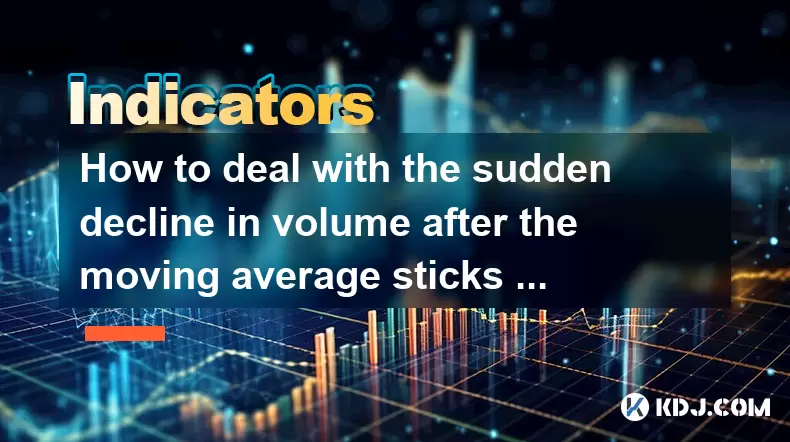
How to deal with the sudden decline in volume after the moving average sticks together?
Jun 25,2025 at 06:35pm
Understanding the Moving Average Convergence and Its ImplicationsIn the world of cryptocurrency trading, moving averages (MAs) are essential tools used to identify trends and potential reversals. When multiple moving averages converge or 'stick together,' it often indicates a period of consolidation or indecision in the market. This phenomenon can be ob...
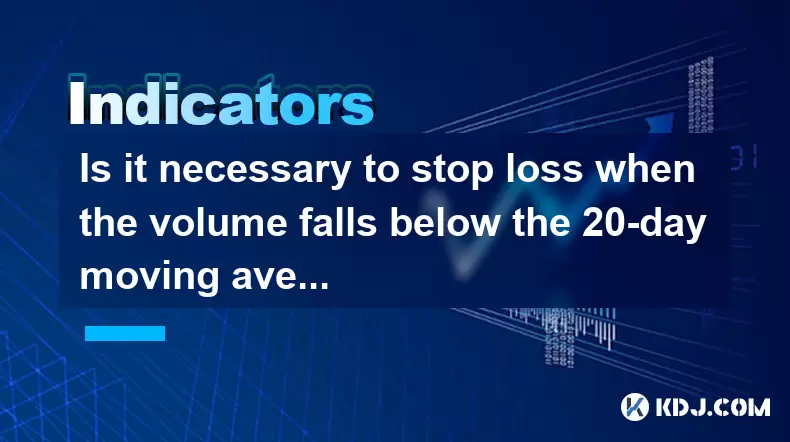
Is it necessary to stop loss when the volume falls below the 20-day moving average?
Jun 25,2025 at 05:00pm
Understanding the 20-Day Moving Average in Cryptocurrency TradingIn cryptocurrency trading, technical analysis plays a pivotal role in decision-making. One of the most commonly used indicators is the 20-day moving average (MA). This metric calculates the average price of an asset over the past 20 days and helps traders identify trends and potential reve...
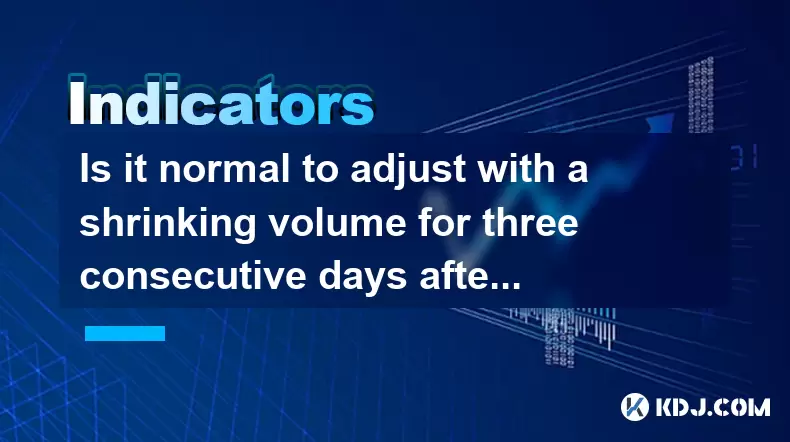
Is it normal to adjust with a shrinking volume for three consecutive days after breaking through the previous high with a large volume?
Jun 25,2025 at 03:49pm
Understanding Volume and Price Relationship in Cryptocurrency TradingIn cryptocurrency markets, volume is a critical metric that reflects the number of assets traded over a specific period. When a cryptocurrency breaks through a previous high with large volume, it typically signals strong buying pressure and market confidence. However, it's not uncommon...
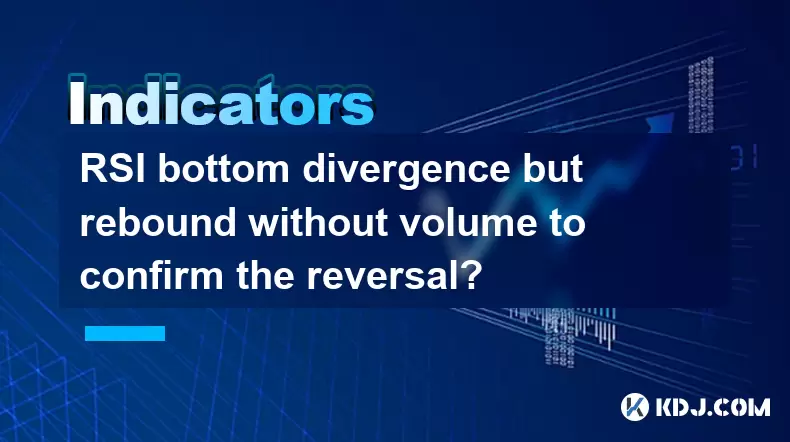
RSI bottom divergence but rebound without volume to confirm the reversal?
Jun 25,2025 at 04:42pm
Understanding RSI Bottom DivergenceRelative Strength Index (RSI) is a momentum oscillator used in technical analysis to measure the speed and change of price movements. RSI bottom divergence occurs when the price of an asset makes a new low, but the RSI does not confirm that low and instead forms a higher low. This pattern suggests weakening downward mo...
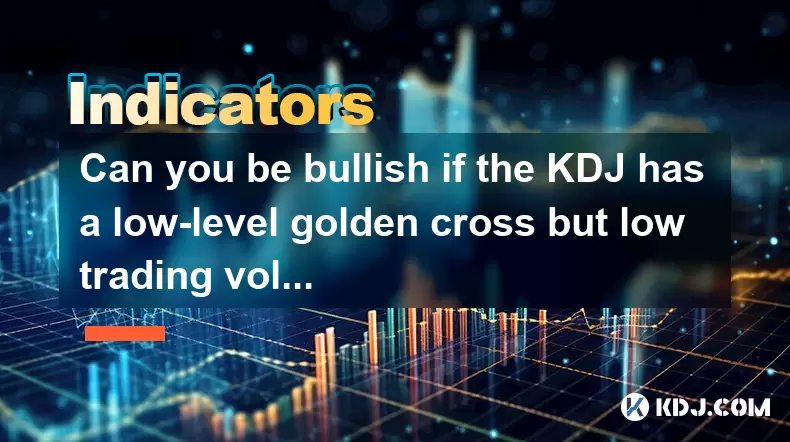
Can you be bullish if the KDJ has a low-level golden cross but low trading volume?
Jun 25,2025 at 03:14pm
Understanding the KDJ Indicator in Cryptocurrency TradingThe KDJ indicator, also known as the stochastic oscillator, is a momentum-based technical analysis tool widely used in cryptocurrency trading. It comprises three lines: the %K line (fast stochastic), the %D line (slow stochastic), and the J line (divergence value). These lines oscillate between 0 ...
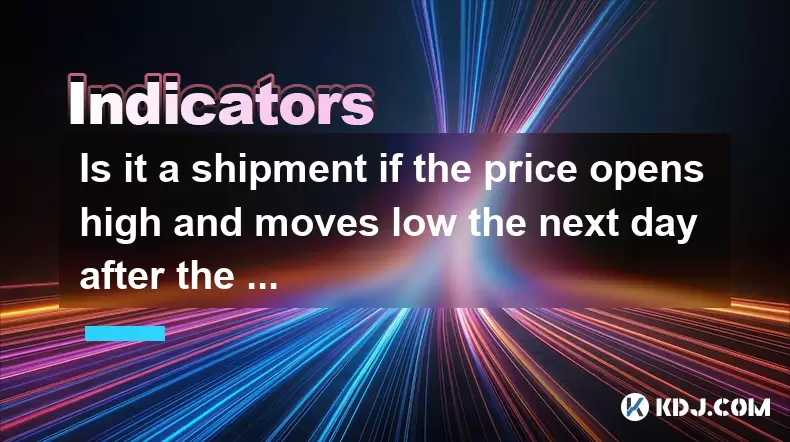
Is it a shipment if the price opens high and moves low the next day after the daily limit with huge volume?
Jun 25,2025 at 12:56pm
Understanding the Concept of a Shipment in Cryptocurrency TradingIn cryptocurrency trading, the term shipment refers to a scenario where large volumes of an asset are sold off rapidly, often leading to a significant price drop. This is typically associated with whale activity or coordinated selling by major holders. When traders observe certain patterns...

How to deal with the sudden decline in volume after the moving average sticks together?
Jun 25,2025 at 06:35pm
Understanding the Moving Average Convergence and Its ImplicationsIn the world of cryptocurrency trading, moving averages (MAs) are essential tools used to identify trends and potential reversals. When multiple moving averages converge or 'stick together,' it often indicates a period of consolidation or indecision in the market. This phenomenon can be ob...

Is it necessary to stop loss when the volume falls below the 20-day moving average?
Jun 25,2025 at 05:00pm
Understanding the 20-Day Moving Average in Cryptocurrency TradingIn cryptocurrency trading, technical analysis plays a pivotal role in decision-making. One of the most commonly used indicators is the 20-day moving average (MA). This metric calculates the average price of an asset over the past 20 days and helps traders identify trends and potential reve...

Is it normal to adjust with a shrinking volume for three consecutive days after breaking through the previous high with a large volume?
Jun 25,2025 at 03:49pm
Understanding Volume and Price Relationship in Cryptocurrency TradingIn cryptocurrency markets, volume is a critical metric that reflects the number of assets traded over a specific period. When a cryptocurrency breaks through a previous high with large volume, it typically signals strong buying pressure and market confidence. However, it's not uncommon...

RSI bottom divergence but rebound without volume to confirm the reversal?
Jun 25,2025 at 04:42pm
Understanding RSI Bottom DivergenceRelative Strength Index (RSI) is a momentum oscillator used in technical analysis to measure the speed and change of price movements. RSI bottom divergence occurs when the price of an asset makes a new low, but the RSI does not confirm that low and instead forms a higher low. This pattern suggests weakening downward mo...

Can you be bullish if the KDJ has a low-level golden cross but low trading volume?
Jun 25,2025 at 03:14pm
Understanding the KDJ Indicator in Cryptocurrency TradingThe KDJ indicator, also known as the stochastic oscillator, is a momentum-based technical analysis tool widely used in cryptocurrency trading. It comprises three lines: the %K line (fast stochastic), the %D line (slow stochastic), and the J line (divergence value). These lines oscillate between 0 ...

Is it a shipment if the price opens high and moves low the next day after the daily limit with huge volume?
Jun 25,2025 at 12:56pm
Understanding the Concept of a Shipment in Cryptocurrency TradingIn cryptocurrency trading, the term shipment refers to a scenario where large volumes of an asset are sold off rapidly, often leading to a significant price drop. This is typically associated with whale activity or coordinated selling by major holders. When traders observe certain patterns...
See all articles























































































